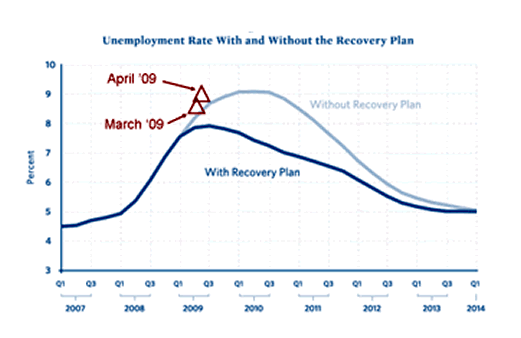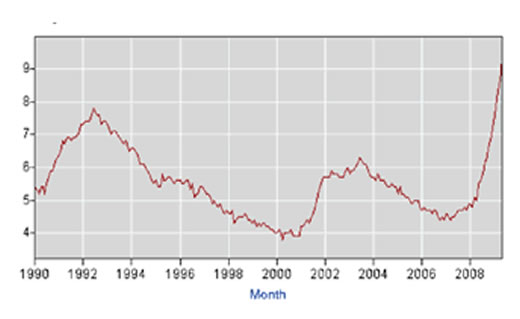Is the U.S. Economy Heading for Stagflation?
Economics / Stagflation Jun 08, 2009 - 04:14 AM GMTBy: Gerard_Jackson
 Irrespective of how Obama's media supporters try to spin it the unemployment situation is grave and still deteriorating. This was not supposed to happen. According to his economic advisors the situation would be disastrous unless congress rushed through Obama's stimulus package. Dr. Christine Romer -- one of Obama's chief economic advisors -- predicted unemployment would hit 8.8 per cent unless swift action was undertaken.
Irrespective of how Obama's media supporters try to spin it the unemployment situation is grave and still deteriorating. This was not supposed to happen. According to his economic advisors the situation would be disastrous unless congress rushed through Obama's stimulus package. Dr. Christine Romer -- one of Obama's chief economic advisors -- predicted unemployment would hit 8.8 per cent unless swift action was undertaken.
Well it was, yet the official unemployment rate now stands at 9.4 per cent and it could exceed 10 per cent. (It would be 16.4 per cent if those workers who have either given up seeking work or have taken a part-time job as a substitute for full-time work were included in the unemployment figures). And its not getting any better. During April and May manufacturing alone shed 310,000 jobs. The chart below was produced by the blogger Innocent Bystander and reveals just how way out Obama's economic advisors' predictions are.

So much for his vaunted claim to have saved 150,000 jobs. None of this should really surprise us. The economic models that Obama's advisors use are worthless. The people who failed to predict the crisis are the same ones who claimed to be able to accurately predict the rate of unemployment at any point between now and the first quarter of 2014. Like all Keynesians Romer has no genuine idea as to how the economy works. And all the time Romer spends pondering her model unemployment rises along with spending and an unsustainable deficit.
Some commentators see a light at the end of the tunnel. They refer to the fact that though the Institute for Supply Management's PMI shows that manufacturing is still contracting it has nevertheless risen by 2.7 over the April figure. I still have my doubts. The Obama administration is the most financially irresponsible one in US history. His outrageous spending and borrowing will lead to ever rising taxes (John Taylor estimates that balancing the budget, even in 10 years time, would require a permanent 60 per cent tax increase) the ramifications of which must inevitable bear down on economic recovery.
There are two forces at work here: the monetary one and the spending one. Since last September there has been a massive and unprecedented monetary expansion during which the monetary base doubled. That Bernanke has created an inflationary time bomb has not eluded the markets. Yields on 10-year U.S. Treasury bonds have been rising and the 30-year fixed mortgage rate exceeded its three-month peak when it hit 5.64 on 7 June. It seems pretty clear that the markets are factoring in an inflation premium.
So industry will find itself facing rising interest rates in the middle of recession due to the Fed's desperate monetary policy. That's the anvil so to speak. The hammer will be the need to compete against the government for funding, adding even more pressure to rates. To top it off massive taxes are waiting in the wings, including an Obama strike against capital gains. Industry will indeed have much to thank Bernanke and Obama for.
All of this helps explain why the economy is not responding as expected in response to the Fed's monetary policy. And monetary policy is what needs to looked at. In any case, the idea that government spending from borrowings stimulates economic recovery is nonsense, as the Great Depression proves. There is also another factor that most commentators ignore.
A number of readers have pointed out to me that the "productivity of debt" seems to be falling, meaning that it requires more and more debt to get a given amount of GDP. This phenomenon is no mystery to the Austrians. Time and time again they pointed out that so-called pump-priming would require ever more injections of money to stimulate economic recovery in order to overcome the accumulated malinvestments that were not liquidated in previous recessions. What we need to consider is whether the point has now been reached where the size of the monetary injection needed to stimulate recovery is now so large that it results in stagflation.
It used to be that recessions were accompanied by falling prices. Because of this few people realised that though prices in general fell consumer prices rose relative to producer prices. In other words, capital goods suffered the greatest price declines. Now that central banks inflate to prevent price declines we can find ourselves in a situation where consumer prices are rising faster than producer prices even as a large pool of unemployed emerges. This is stagflation.
The logic of this line of thought leads to the conclusion that a stagflationary trend would be reflected in a weak demand for labour. As the money supply increases unemployment still rises followed eventually by accelerating inflation. What this means is that a point is reached where the level of unemployment rises for each consecutive recession and where bringing it down requires greater amounts of monetary injections. The following table is from the Bureau of Labor Statistics.

The left hand side of the chart is the percentage of unemployed and the bottom is the period 1990 to 2009. Note that in 1992 unemployment peaked at 7.8 per cent. The next recession saw unemployment peak at 6.3 in 2003. (I believe that by cutting the capital gains tax by 33 per cent and the tax rate on corporate dividends by more than 50 per cent President Bush reversed the rise in unemployment). The current recession has the official unemployment rate at 9.4 per cent and rising. This is very worrying
Inflation works its black magic by widening firms' price margins thereby causing them to expand output. Considering the present monetary situation and Obama and the congressional Democrats' destructive tax, energy, regulatory, borrowing and spending policies I cannot see where a widening of price margins -- if they do occur -- can bring about a sustained recovery.
People do not seem to realise that the other term for economic growth is capital accumulation. There is absolutely nothing in Obama's economic program that will cause the capital structure to expand. On the contrary, everything points to a contraction. This means that real wages and living standards would have to fall.
By Gerard Jackson
BrookesNews.Com
Gerard Jackson is Brookes' economics editor.
Copyright © 2009 Gerard Jackson
Gerard Jackson Archive |
© 2005-2022 http://www.MarketOracle.co.uk - The Market Oracle is a FREE Daily Financial Markets Analysis & Forecasting online publication.



